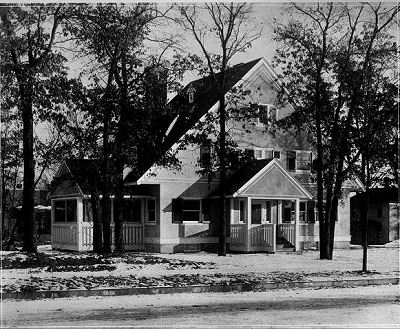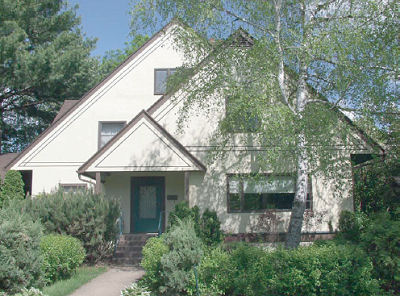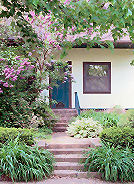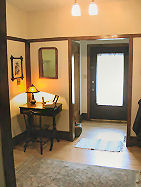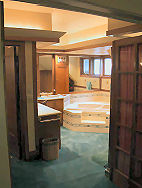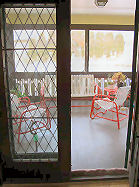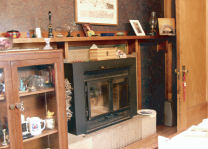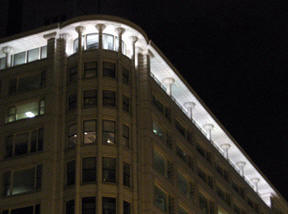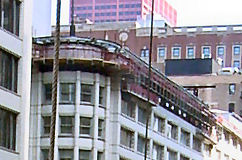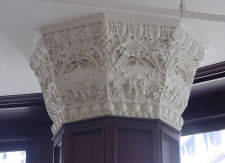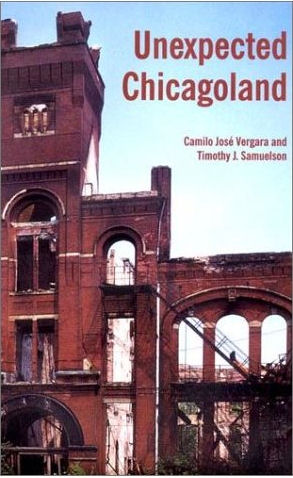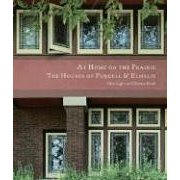 |
firm active: 1907-1921 minneapolis, minnesota :: chicago, illinois |
Ye Olde Grindstone
9/30/2006
Original front, 1915
Parsonage for the First Congregational Church
Eau Claire, Wisconsin 1912
Front elevation, 2006
Photograph from sales brochureEn Passant. Just a brief Grind this week as work here goes more into the invisible background behind the shadows on the screen. I am intent on resolving the remaining coding issues to restore the indexing features on Organica at large, and have been spending many hours learning the new ASP.NET 2.0 data structures. The results will be worth it, but the extensive time sink involved precludes the usual content here. So, that in mind, here's the news:
The owner of the Parsonage built by P&E in 1915 for the First Congregational Church in Eau Claire has kindly corresponded to say that the house is up for sale. Our readers have been provided a PDF of the sales brochure (PDF: Best to use "right click, save link as"). There are nine current small photographs that make the glimpse worthwhile for those that can. A few are excerpted below for those to whom the bandwidth is onerous. I did inquire about the framed original letters from P&E that were on the walls when I last visited the house, and was advised that those were thoughtfully retrieved by the current owner from a former one and will remain for the new residents. A new phase of life begins.
Parson's office entrance
Front hallway
Bathroom
Porch doorway
Den fireplaceAs was noted last Grind about the nearby Community House for the First Congregational Church, there is a commonplace misunderstanding about the Parsonage, as well. The house was altered at some point, and the living room extended. Thus, the current front elevation of the house is not as designed by P&E. However, you have to give points to the architect who made the changes, for there is such evidence of concern for visually integrating the change into the original structure that most people do not detect the accretion without being told to look.
Night view, showing completed work
Loggia being repaired, 2005
Sales floor capital, which would presumably become invisible to the public if incorporated into a [premium] corner office space.Schlesinger & Mayer Dry Goods Store
later (not much longer) Carson, Pirie, Scott
Louis H. Sullivan and George Grant Elmslie, architects
Chicago, Illinois 1900/1903Additional detail images of terracotta, plasterwork, and metalwork from my visit in May, 2005, have been added for elements of the Schlesinger & Mayer (Carson, Pirie, Scott) department store in Chicago. News also arrived recently that this venerable store will close in early 2007 and may be converted into office space. On the one hand, the owners invested significant sums to restore the loggia colonnade tucked beneath the bonnet of the eave. However, given the likely use of the interior spaces, I wonder how much of the interior finish will disappear beneath drop ceilings and partition walls -- never mind the white elephant of public access. Check out an insightful discussion of the loss of State Street shopping, with some recent views of the sales floor while it still is one.
Appropriately, the Pullman Company Buildings make the coverI can only feel sad for Chicagoans, who have also experienced the rueful indignity this year of seeing Marshall Field's retooled into the homogeneity of a Macy's. Given the number of times the store has changed hands in recent decades, pretty soon there won't even be a need for names, just disposable string banners from Acme Signs saying "The Feckless Corporation That Owns The Space This Week." That the City of Chicago allowed such a defacement of their own history speaks for itself -- but then, they permitted the demolition of the P&E Edison Shop, too, after voting it the fifth most important historical building in the Loop. A enlightening book that reveals the broader story of disintegrating historic architecture in Chicago is Unexpected Chicagoland, by Camilo Jos Vergara and Tim Samuelson. If you haven't seen the film yet, I highly recommend getting the DVD of The Corporation. There's even a newer 2-disk set. If you've ever wondered how, exactly, our culture turned away from the shining horizon pointed toward by Purcell & Elmslie and we wound up in a 21st century ash heap of sociopathic dissociation, this movie lays it out pretty clearly.
Finally, At Home on the Prairie: The Houses of Purcell & Elmslie, the P&E house book by Dixie Legler and Christian Korab has become visible at Amazon, though the release date is December 1, 2006. The side effect of this and newly appeared Gebhard book is that I have been contacted by editors from various university and commercial presses about when my book is going to be done. Alas, no one has yet suggested an advance sufficient to move it forward one iota. And with that nod to continuity, I am off to the bowels of datareaders and webcontrols. Beep, beep. Vrooom.
9/22/2006 Still not there.
Mea culpa. I got involved with
keystrokes other than transcribing the section of the Purcell manuscript
related to the 1906 trip to Europe, so again that ship has not yet sailed.
Instead, I started working on the massive backlog of images that have sat
here waiting for me to get them up and got on something of a roll even
though this Grind is technically late. In the Duck, Quack Department, some 40
images contributed by John Panning have been added to the
Parish House and Chancel for Christ Church
in Eau Claire. Let Purcell explain, which he
really wants to do: "This
job was a poser for a young fellow fired up with Louis H. Sullivan fuel
and deeply convinced of the need for indigenous American architecture." I
know, you know, he knew that this was about maintaining valuable contacts
in a prosperous town where there was much work to be had. This commission
is largely overlooked by most people who examine the work of the firm, and
well might that be a good thing, I suppose, in comparison to the purer
visions found in the rest of the P&E commission list. I have always viewed
it as the perfect form of contrast, a demonstration that Purcell and Feick
could have done perfectly well amid the revivalists had that been their
path. Instead, the Christ Church shows clearly their comprehension of the
devil against which their minds and spirits were arrayed. They just
tweaked the horns. P&E were rewarded for their patience,
along with us, with that feast for the eyes that is the
Community House for the First Congregational Church,
which we now view with 22 new vantage points
thanks to John. This is one of the few P&E projects where the initial take
on the building elevation changed radically from the final construction.
Partly such was due, no doubt, to the enthusiasm of the firm that the
driving force for the commission, the woman who was footing the bill, had
a strongly modern outlook. Yet, in the end, the conservative sensibilities
of the whole flock leaned heavily upon the design. The final result is
starkly different from the original conception. The facade as built incorporates what is clearly
a familiar form of ecclesiastical detail, yet one rendered with such
perfect delicacy and integral relationship with the whole that the
enrichment poetically references but effectively belies the taint of
revivalism.
There is one mistake
that happens frequently when people look at the Community House and the
adjoining church building. Most people assume that the Community House was
an addition to the sanctuary. In fact, the opposite is the case. The
Community House survived a fire in the 1920s that took down the original
church, and Purcell recounts this as the conclusion of his
Parabiographies entry for the project. The
current life of the building did away with the basketball court long ago,
and the space now serves as a Sunday School and Nursery. The congregation
is clearly proud of the legacy, and treats the building with a refreshing
respect and obvious enjoyment. Part of
the reason for this simplicity was so that client would not mistake
the idea of the building, which is all that the design was at the
point of service for the drawing, for the actual thing it would become
in tangible built presence. The usual P&E presentation drawing is
almost always an elevation, flattened on the plane of the paper. Only
rarely did a job command the time and expense of more elaborate
representational, perspective views like Weber used for the Powers
decorating scheme. Beyond the grave goods of a b&w photograph we are likely never to
know more of what was possibly the finest of the P&E renderings, done for the
Institutional
Church for Charles O. Alexander, project (Y.M.C.A.) which was to have been built in Siang
Tan, Hunan, China. Poof, vanished, gone without a trace. There was also a special oil rendering done by Charles Chapman for the
Woodbury County Court House that had its own
commission number. That perhaps has a better chance of showing up, as
it was left with the client. Purcell tried to inquire of the Sioux
City folks in the 1940s, but couldn't get a straight answer. Perhaps
they came
upon this painting during their restoration effort but, if so, I have
yet to see a photograph. We have no true sense of what the drawings for the P&E
submission to the
Australian Parliament Buildings Competition really
looked like, either, since Elmslie left them outside on a porch to
merge with the winter snows, even though the original plain bumwad
sketches miraculously -- and accidentally -- survived forgotten in a
flat file drawer. The most comprehensive set of surviving renderings is the suite of
sketches prepared for the First National Bank, project,
which present several alternate facade schemes. In my experience --
and making the aforementioned P&E point about why such drawings were
usually eschewed -- many
people react to these drawings as art objects before they look at them
as conveyances for architectural design. There is also in this group
the unique use of a transverse section in a P&E presentation, rendered
at substantial expense by enriching a hectograph with colored pencils
and paint. Of course, it was from these drawings that Tom Ellerbe
ripped off P&E's design to thieve the commission, the ultimate form of flattery
that hits below the belt, in the wallet. Everyone should read the
trenchant editorial that appeared in
The Western Architect when this perpetration of ethical failing
was exposed for all to understand.
Also, to come full circle, the formal Christ Church rendering (alas, I lack a color representation)
is an angelic exercise in celestial pastels. Reproduction can never do it
justice.
Thus, one duck, a goose by Ellerbe, and
many swans later, we have arrived at the end of our current pool of
consideration. And thanks again for the contributions of Caravan member
John Panning. I won't even bother with a
Next Up, because who knows? There are hundreds
more images begging to be tagged and released. Presentation rendering (b&w facsimile) A "legible" view of the image at a higher resolution has
been added to the project page.
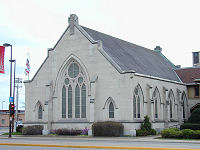
Exterior, main sanctuary
Parish House and Chancel for Christ Church
Eau Claire, Wisconsin 1908/1915
All photographs by John Panning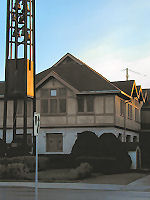
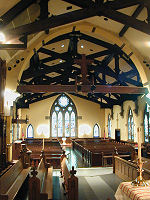
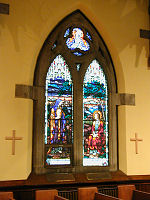
Exterior, Parish House
Interior, sanctuary
Window, sanctuary
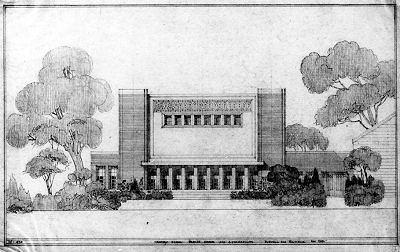
Presentation rendering
Community House for the First Congregational Church
Source: Images Database, University of Minnesota Libraries
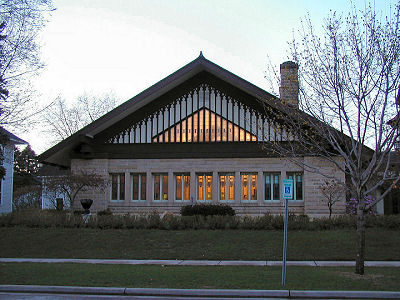
Front elevation as constructed
Photograph by John Panning
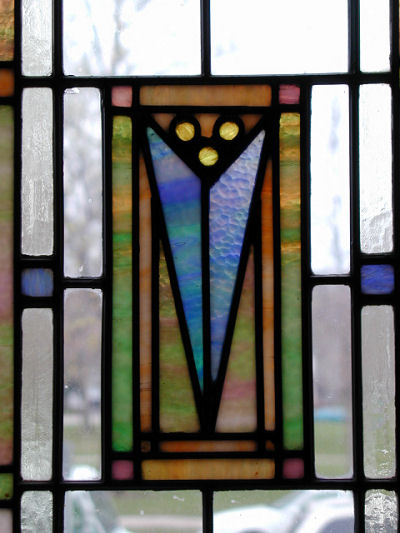
Detail, leaded glass panel
Community House for the First Congregational Church
Eau Claire, Wisconsin
1913
Photograph by John Panning
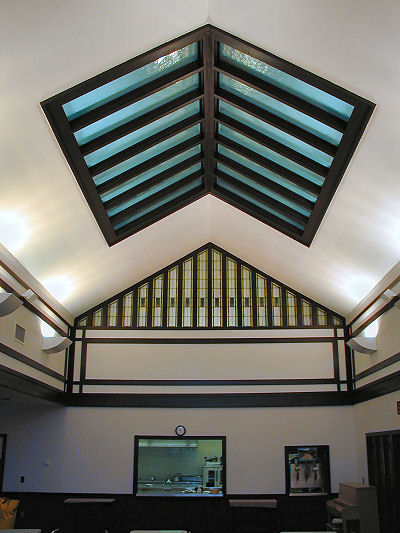
Interior,
looking toward kitchen
Community House for the First Congregational Church
Eau Claire, Wisconsin
1913
Photograph by John Panning
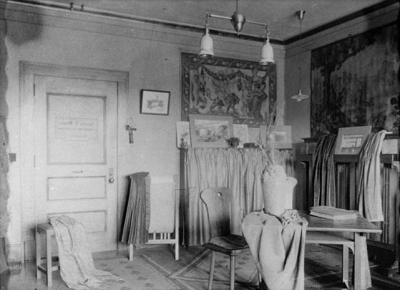
Gustav Weber Studio
Minneapolis, Minnesota 1915Some more
miscellaneous images have been added hither
and thence, including one of Gustav Weber's interior design
establishment. Four images from the 1930s of the later iteration of the
firm, Weber Werness Studios, are available from the
Minnesota Historical Society website
[type in "weber werness" on the search line], when the studio was in
the Handicraft Building. The sales floor purveyed home furnishings in a space where, at least last time I was there, you
can get a decent omelet and some trail cakes along with fresh squeezed
orange juice. The Handicraft Guild building, for which Purcell & Feick did
a "consultation," is more or less
intact, though decayed throughout much of the interior from sheer
neglect over the decades. It was to the auditorium of this space that
Purcell shepherded H. P. Berlage for the great Dutch architect to give
a talk to the local architecture community when he visited Minneapolis
in 1911 while on his tour of the United States. I have always felt sad
for Berlage, who was so homesick by this point in his lengthy American
sojourn that he failed to take the train an hour south to Owatonna to
see the
National Farmers' Bank, arguably
the finest of all the Progressive buildings that were the object of his
travels. There that evening
Purcell also met John Jager, who eventually came to be called the
"silent partner" in P&E. The Arts & Crafts-oriented Handicraft Guild
proved to be an assembly area where Purcell, Elmslie, and the Team
were prone to circulate in the closest they had to an local arts community
of peers, I suppose because the place had seats.
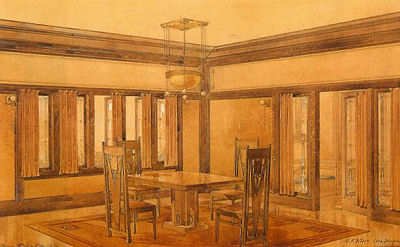
Dining room presentation rendering by
Gustav Weber
Edward L. Powers Residence
Purcell, Feick, and Elmslie
Minneapolis, Minnesota 1910
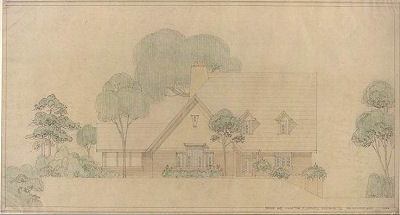
Presentation rendering
Clayton F. Summy residence
George Grant Elmslie, architect
Hinsdale, Illinois 1924
Probably my favorite presentation rendering in the Purcell collection
is the one done by Weber for the dining room of the E. L Powers
residence. Intensely lush with poetic warmth, the drawing is a fair
prophecy of the feeling intended in his interior decoration of the
room -- even if the table did wind up being round instead of
rectangular. It is the exception, however, rather than the rule,
something brought home to me as I rescanned to modern display resolutions a
number of the earliest images ever to appear here, originally done in 1996. The
vast majority of P&E renderings were done on tracing paper with colored pencil.
A perfect example of the standard issue is the one given to Purcell's in-laws
for the Clayton F. Summy residence. Even though
it was created in 1924, this drawing invokes perfectly the presence of all those that
came before.
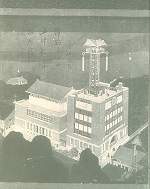
Presentation rendering
Institutional Church for Charles O. Alexander, project
also known as "Y.M.C.A"
Siang Tan,
Hunan, China 1916
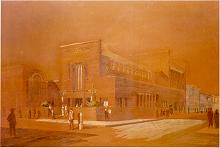
Principal scheme
First National Bank, project
Mankato, Minnesota 1911
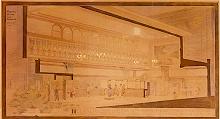
Transverse section, main banking room
Principal scheme
First National Bank, project
Mankato, Minnesota 1911
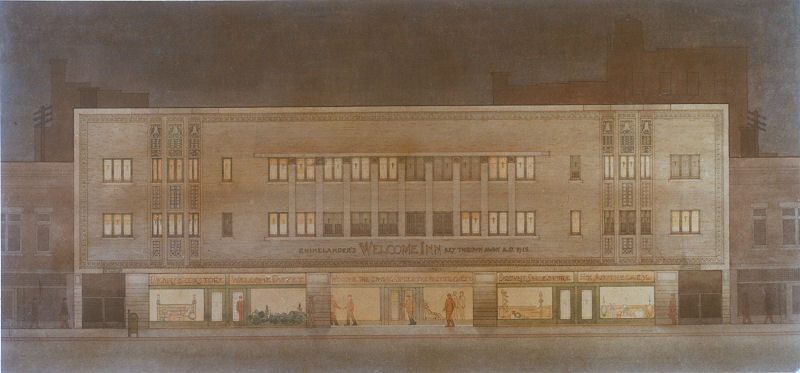
Presentation
rendering
Welcome Inn Hotel, project
Watercolor and colored pencil on paper,
mounted on a masonite panel in the 1950s
Rhinelander, Wisconsin 1915
Of the other formal presentation drawings that
remain, t
he
large
"Welcome Inn" project
rendering done for the Rhinelander hotel project is superbly articulate and
conveys a strong architectonic sense while being confined to a flat front
elevation (above is a fresh higher resolution scan, somewhat treated for
color adjustment, different than what's on the project pages). I have always
wished to see the real drawing for the
Riverside Country Club, which we have only in the lithograph that appeared
in The Western
Architect in 1915. The print reproduction is fine enough for the time and
purpose for which it was made, but the publication process resulted in an image that
is cheesy to my eyes. Certainly the original could have been right up there
among the best that ever came from the P&E office. Just possibly the club
still has it.
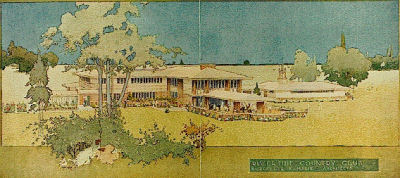
Presentation rendering
Lithograph insert to The Western
Architect (1915)
Riverside Country Club
Purcell and Elmslie
Riverside, Illinois
1914
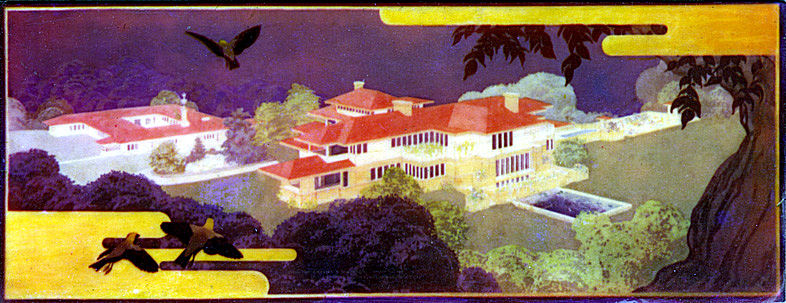
Presentation rendering, in collaboration with
John W. Norton
Color image originally from Hess-Ives separation negatives, 1915
Charles O. Alexander residence, project
Philadelphia,
Pennsylvania 1915
Source: University of Minnesota Libraries online U Media Archive, University of Minnesota Libraries
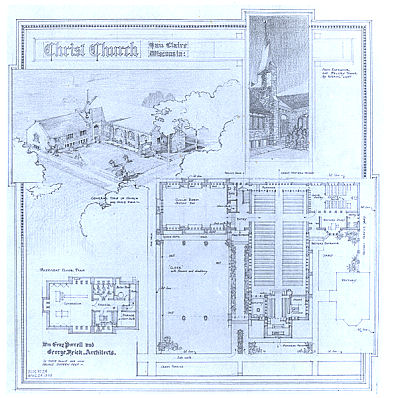
The last all presentation renderings done for
clients was the one John Norton collaborated on for the
Charles O. Alexander residence, project
in Philadelphia. Again we have only a photograph, albeit in color through a
Hess-Ives separation. Again, I have processed the available image to
enhance the contour sharpness, and this view is, I think, better than the one
otherwise available on-line.
Parish House and Chancel for Christ Church
Eau Claire, Wisconsin 1908/1915
9/7/2006
With the occasional
exception of indexing code that still needs to be adjusted to recognize
the new directory structures, the following Organica sections are working
again. Between August, 1979
and mid-1986 I worked to complete a roughly 800 page manuscript to serve
as a guide to the Purcell Papers. It was converted in the 1990s to work
through the HyperFind software. The advanced indexing features have been
restored, and are visible on the entry page. The original version of the HyperFind
software built web "exhibits" from
databases on the fly. While this is very primitive compared to what can
be done today, when it was built in 1994 it was cutting edge. The
Director of the National Digital Initiative at the Smithsonian stood at
my desk and said that I had solved problems his engineers had just
realized were there. It was a nice thing to say, but it scared the
supervising librarians standing nearby. Until I can complete building
the new interface with web controls that mimic the actual Windows
application in the browser, the old views will have to appear. This resource had just
been barely up six months or so before the old server died. It looks a
little scrawny now, of course, but just needs attention. The current
resurrection does contain Martin Hackl's wonderful presentation on
John S. Van Bergen. So, dice are rolling and the knives are
out. Further developments portend.
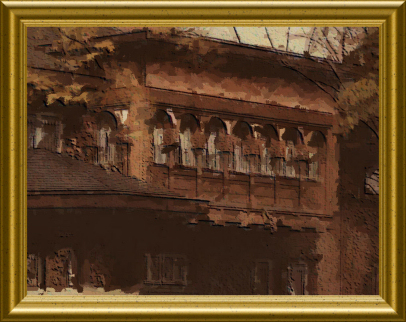
"Demolition
Henry B. Babson residence
Mark Hammons 2005
Successful Relaunch.
Most regular readers of this
blog won't care about the technobabble reported in this issue, but they
will care about the resources newly restored to accessibility. For nearly
three years since the death of that 10 year old Pentium I that was the
Organica server for so long, much of what can be delivered through
Organica was off-line. The HyperFind
system on which the vast majority of information here was based simply
didn't have any way to work. With the advent of a rescued Pentium 3 coming
into service, complete with a hard drive harvested from a castoff carcass
in the dumpster, the effort to bring the HyperFind
modules back into service has been accomplished.
9/3/2006 "Troubled Buddha"
With the rent twenty-one days late, the
drama and my transformation in this experience cannot be overstated. Most
people don't have a chip set for being about four minutes from the
lifestyle of the street through the ministrations of the LA County
Sheriff. Heaven knows the spaces beneath the bridges in LA are already
fully occupied, so me, my cats and what few possessions I might have
salvaged would have been on the sidewalk. While I explained this situation
to the person in question only as an understanding of why uploading some
images would likely not happen and making the point this was not his
concern, he turned around and made it one. I have never been paid a higher
compliment in my life than my name being expressed next to Louis Sullivan
in the same condition and being deemed worthy of salvation. My command of
language is overwhelmed by this kindness from someone I have never met.
With this act of grace, the Cause in the shape of my footprints is moved
forward to another set of days. The whole experience has reaffirmed for me
that what I do here has merit, provides interest, and conveys value for
others. For the deliverance of my life from disaster on the wings of that
judgment by someone who prefers to otherwise remain anonymous, I am
profoundly grateful. Synchronously, the old cast off computer
that sat here for almost a year unwilling to work has miraculously decided
to function, and Progressives On-Line, the Prairie School Exchange, and
the Guide to the William Gray Purcell Papers can now be restored to
service. That's what I am working on at the moment. Once that is up, I can
resume the addition of materials here. Salve!
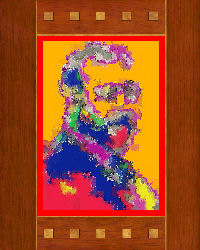
Portrait of Louis Sullivan
Mark Hammons 2005
Buck Up. First, everyone
who reads this page is doing so because of the generosity of a member of
the Caravan who chose, out of sheer humanity, to save Organica and, not
coincidentally, my life as I know it. After staggering forward since 9/11
on mostly willpower, I arrived at the bottom of the barrel in August,
2006. An architect for whom I work owed me six weeks of back pay and did
not have the money. I received an eviction notice. You could just see the
management company salivating at the opportunity to raise the rent in this
otherwise rent-controlled apartment another $500 a month after moving me
out. Such is the day-to-day rapacity of economic challenge in Los Angeles.
Sure, it's the City of Angels, but they don't tell you these are
predominately from all I have seen the ones that sided with Lucifer.![]() research courtesy mark hammons
research courtesy mark hammons
